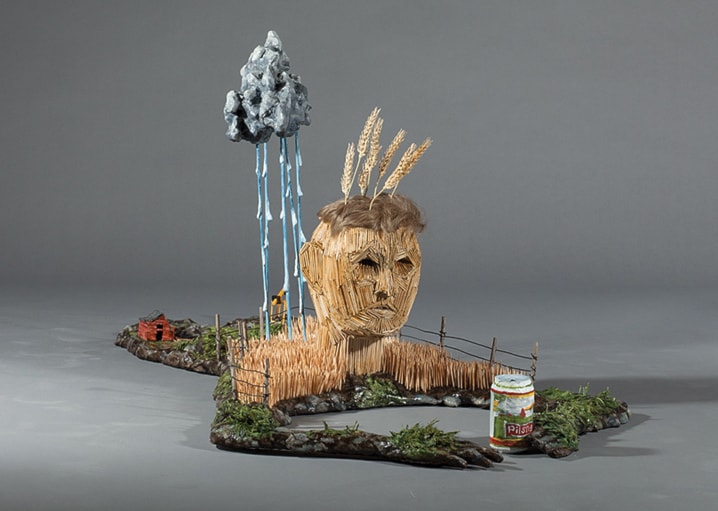Farmyards, compost heaps and oil derricks take on human proportions in the art of Jude Griebel.
The Sundre-based artist actually describes his latest papier-mâché and epoxy-resin sculptures as self portraits. And sure enough, a face resembling Griebel’s own grows out of a grain field in his life-sized creation, Wheat Country — one of his works exhibited in Future Station, the Art Gallery of Alberta’s 2015 Biennial of Contemporary Art in Edmonton.
The two-metre-long sculpture depicts a male figure, lying on his stomach and emerging from a landscape. A rustic barn sits on one of his legs, while on the other is an oilfield pump jack. The figure’s left hand, covered in prairie grasses, encircles a can of Pilsner beer.
“In my works, the body acts as a stage for scenarios,” said Griebel, whose life-sized sculptures, quite literally, show human beings shaped by their environment.
But when interpreted on a psychological level, his dimensional works suggest something else. For instance, Wheat Country could signify the casual acceptance of industrial activities on farm land.
Griebel said his wheat man sculpture depicts both Alberta’s farming tradition and what’s happening to it. “It’s where we come from and where we’re going.”
Although environmental concerns are evident in his art, Griebel emphasized his themes are always more personal than political.
“The works are more self-critical, as a consumer, than finger-pointing,” said the 36-year-old, who studied at Montreal’s Concordia University, the University of Lapland in Finland, and Vancouver’s Emily Carr University of Art and Design.
Although he started out as a drawer and painter, Griebel was inspired to create more sizable, dimensional works by the “didactic models” used by museums to put conceptual information into more concrete terms — as well as crafty and theatrical papier-mâché Halloween costumes he made for himself as a boy.
His organic, homespun creations are the opposite of industrial-themed art. His sculptures often incorporate human hair, wood and other materials, but virtually every component — even the Pilsner beer can in Wheat Country — is crafted by the artist himself.
His sculpture Accidental Mouth shows the blowing mouth of a wintry visage about to cause a three-vehicle accident. Griebel could have appropriated factory-made Matchbox cars for the piece. Instead, he chose to fashion each diminutive vehicle out of paint and resin.
“I think it’s important to create all the details, so the overall feeling of the piece, all the surfaces, retain the same quality. I’m creating an overall illusion,” said Griebel, who believes it hangs on handmade intricacies.
Accidental Mouth can be interpreted as reflecting the annual havoc Old Man Winter creates on Alberta roads, or it can be viewed as being about social anxiety and the fear of a misspoken word leading to disaster, said Griebel. “A lot of my works relate to psychological circumstances. ...”
Composting is another of his sculptures showing at the Art Gallery of Alberta. It depicts a reclining figure made of compost materials with an iPhone in hand. Griebel said the work says something about time spent on cellphones. “It’s a personal criticism of myself as much as anyone else. ...”
But it also brings to mind the many composting heaps seen on rural properties.
While the Ottawa-born artist grew up in Saskatoon, his neurosurgeon father and art conservator mother maintained a link to rural Alberta through a family homestead near Castor.
Griebel and his brother spent holidays there and formed a childhood attachment to the Prairie landscape.
About a decade ago, Griebel’s parents bought an acreage near Sundre. He maintains a studio on that site, and spends part of the year there working on sculptures. The rest of his time is spent in Germany, where the artist shares studio space, has gallery representation and an appreciative following.
He believes the art-loving Europeans are also quite ecological-minded. Germans are very aware of Canada’s natural abundance and the international controversy over Alberta’s “tar sands,” said Griebel, who’s concerned about global warming and other signs of humankind’s incompatibility with nature. For this reason, his artistic themes often centre on notions of unease, transformation, growth, change and mortality.
For the Biennial of Contemporary Art, he also created a separate grouping of five sculptures being exhibited in a storefront window in The Gibson Block flatiron building at 9608 Jasper Ave.
The pieces include a sitting figure with the head of a barn and a humanoid oil derrick. The work, collectively titled Feeder, makes a statement about growth and consumption on the Prairies.
“It’s as if the saying ‘you are what you eat’ is taken to a monstrous level,” said Griebel, who lets viewers reflect on their own physical and psychological connections to the natural world.
The biennial exhibition is on in Edmonton until May 3.
lmichelin@www.reddeeradvocate.com
